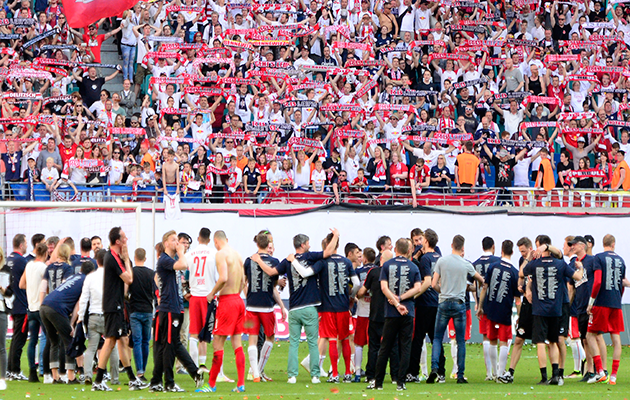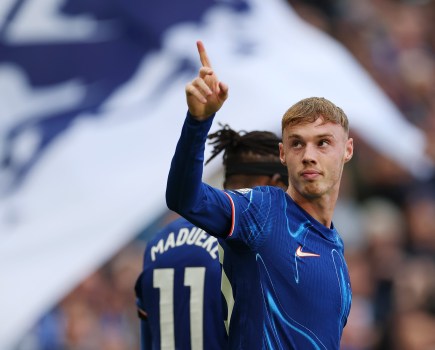Ralph Hasenhüttl shed tears in his final home press conference as Ingolstadt manager, after his side’s 2-1 defeat against Bayern Munich.
Hasenhüttl had guided Ingolstadt to the Bundesliga last year and two weeks earlier a 2-2 draw against rock-bottom Hannover had ensured their survival this term. But his tears weren’t borne from joy, nor was the final home match of the season against Pep Guardiola’s newly-crowned champions a celebration of a fine campaign.
He’d recently agreed to take over at RB Leipzig, who sealed their promotion to the top tier of German football as runners-up from the second division thanks to a 2-0 win at home to Karlsruhe on Sunday. The Austrian-born manager had been booed by his own fans during the Bayern game, despite Ingolstadt registering more shots against the Bavarians than any other Bundesliga side this season. Some supporters held up protest banners, one of which which read: ‘You’d rather be Rangnick’s jester than (Ingolstadt’s nickname) King of the Schanzer?’
Ralph Rangnick, who will move upstairs to make room for the new incoming boss, pulled his hamstring while trying to evade a traditional ‘beer shower’ from his players during the celebrations. Even that is unlikely to raise much more than a half-smile from anyone associated with Ingolstadt.

RB Leipzig coach Ralf Rangnick will move upstairs after guiding the club to promotion.
When Markranstädt, a club from just outside Leipzig, became RasenBallsport Leipzig (and not “Red Bull” Leipzig like their Salzburg-based counterparts) in 2009, a Red Bull spokesman told Der Speigel that “the Hoffenheim model” was the route for them; namely, to spend big.
That’s played out over the years; in the summer of 2014 their spending accounted for 50% of the total money spent on transfers in the entire 2.Bundesliga. Last year, Davie Selke became the division’s most expensive player following his €8 million move from Bundesliga outfit Werder Bremen. Rangnick is said to have been handed a €100 million transfer budget when he took over in 2012, two years after the club had moved into the 44,345-seater Zentralstadion which was vacant having been built for the 2006 World Cup. In case you were wondering, it’s now named the RedBull Arena. Still, the €5.1 billion that Red Bull made in revenue in 2015 should be more than enough to cover all that.
Their progress has not been linear, or easy. Disgruntled Markranstädt fans laced the pitch with herbicides to protest against the news of their club’s sale to an energy drink manufacturer broke, while 20,000 FC Union Berlin fans adorned themselves with black ponchos and sat in silence for the first 15 minutes of their clash against Leipzig in 2014. Behind one of the goals a banner read: “In Leipzig stirbt die Fussballkultur” – In Leipzig, the football culture is dying. They’re often booed and jeered by opposition supporters.
Their rise to the top tier has had an air of certainty about it, however. Three years in the fourth division, a year in the third and two in the second later, RB Leipzig have fulfilled at least part of their destiny, laid out by Red Bull owner Dietrich Mateschitz. “We are developing RB Leipzig with the aim of playing in the Bundesliga in three to five years,” the Austrian said in 2011. “We also want to get into the Champions League and be successful there, which is something you can only achieve with a club that plays in one of the top leagues.”
Now the dam has burst and a tide is soon to be unleashed. Those who follow German football closely have seen this moment coming for some time. The complaint isn’t simply against Mateschitz’s millions though, but how his test-tube team rubs against the tradition and spirit of the game, as well as one of the country’s core football principles; fan ownership and the notion of 50+1. Although RB Leipzig don’t technically break the rules that govern the game, the fact they pay only lip-service to fans being majority owners prompted German journalist Christoph Biermann to write in 2014: “It’s hard to imagine a more blatant way in which RB Leipzig could break the 50+1 rule.”
“In countries like Germany, a fan base derives its identity from the particular history of its club,” Boris Haigis, from Wuerzburg University’s Institute of Fan Culture, told Vice Sports recently. “Red Bull is therefore a red flag for many other fan groups. There is no decade-long tradition behind it, but it tries to buy everything.”
When August comes, and the Bundesliga matches begin, Hasenhüttl’s side can expect a reception similar to the ones factory-owned teams such as Wolfsburg and Bayer Leverkusen receive. Namely, frosty.
But there is another side to this story. Not long after their inception, the residents of Leipzig were asked, in a survey by Leipziger Volkszeitung, about Red Bull’s invasion of Markranstädt and almost 75% agreed it was a good thing. 43,000 fans were present to witness their crowning moment against Karlsruhe, and thousands lined the streets, in an area deprived of success or national attention, to greet the team atop a double decker bus as the team celebrated promotion. Red and white confetti, the colours of Red Bull, covered the pavements. That feeling of new money and success transcends the pitch too; Amazon and DHL, BMW and Porsche have all set up camp in Leipzig in recent years to create thousands of jobs and help the population grow 10% to over 530,00 people. 25 years on from a city on the verge of literally crumbling to the ground, it is perhaps now the most potent example of capitalism in the east. Some even call it the new Berlin.
East German football isn’t meant to be like this, though. Not really. FC Union Berlin, the famously anti-stasi leaders of football’s socialist movement alongside St. Pauli, whose fans gave up 140,000 hours of their own time to re-build their stadium between 2008 and 2009, and donated blood in order bridge a financial hole the club found themselves in four years earlier, will end the year well off the pace.
They were meant to be the ones making the leap. “Unification has not been kind to the clubs from the former German Democratic Republic ,” wrote Erik Jullander in the Guardian back in 2012. “Several clubs that used to be so successful never found a way to make it in the new world of free market and capitalism…that is why so much hope is attached to Union.”
RB Leipzig, seven years on from their controversial inception, bankrolled by a billionaire, named after an energy drink and loathed by a large portion of German football supporters, will be the first representative from East Germany in the Bundesliga since Energie Cottbus were relegated in 2009.
This wasn’t meant to be the way. But the GDP gap between east and west is now bigger than it was in 1991, while the unemployment rate is markedly higher in the east compared to their wealthier compatriots. Perhaps, as a sign of the times, the Red Bull way is the only way, for now at least, to bring the east back into the football fold. Coming up for 27 years since the Berlin Wall fell it seems as though another barrier has just been broken, for better or worse.
By Pete South
This article originally appeared in In Bed with Maradona







